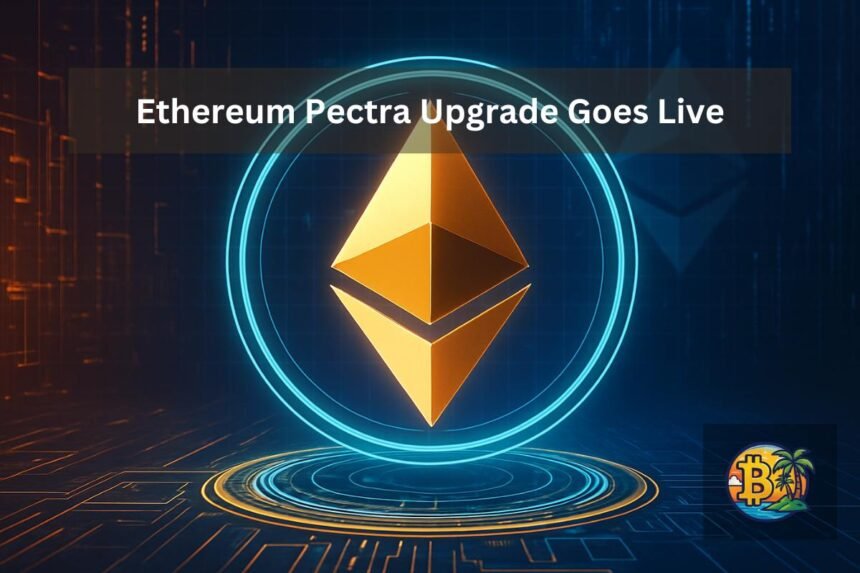Key Insights
- The Ethereum Pectra went live at epoch 364032 around 6:05 a.m. ET on 7 May.
- The Ethereum network has been criticized because of its high gas fees, complex staking requirements, and issues with onboarding new validators.
- However, successful testing on Hoodi in March cleared the road for today’s release.
- The Pectra upgrade introduces 11 major EIPs, providing scalability, useability and major upgrades for validator operations.
- Pectra is a major step in the right direction, as it balances performance improvements with great compromises on decentralization.

Ethereum has just rolled out one of its biggest updates since the Merge in 2022.
This upgrade is called Pectra, and went live at epoch 364032 around 6:05 a.m. ET on 7 May.
This upgrade is packed with 11 Ethereum Improvement Proposals (also known as EIPs).
In general, Pectra is designed to boost the network’s staking efficiency, streamline validator operations and improve user/developer experiences.
Another important thing to note is that Pectra builds on the momentum of Dencun, which brought proto-danksharding to the network.
With Pectra, Ethereum is now preparing for the upcoming Fusaka upgrade and the deeper scalability improvements it promises.
Here’s a few insights on what Pectra brings to the table, as well as why it matters.
The Pectra Upgrade And What It Brings
The Ethereum network has been criticized for a long time, because of its high gas fees, complex staking requirements, and issues with onboarding new validators.
Pectra is geared towards fixing many of these problems by improving how Ethereum handles aspects like smart contracts, staking, data storage and Layer 2 support.
Before launching on the mainnet, Pectra spent months in testing mode via the Holesky, Sepolia and Hoodi testnets.
Even though these environments suffered a few configuration issues (especially around validator settings on Holesky) successful testing on Hoodi in March cleared the road for today’s release.
The EIPs That Make Up Pectra
As mentioned earlier, Pectra introduces 11 improvement proposals, all of which are aimed at improving user and developer experience across the board.
Here are a few of them:
EIP-7702 And Account Abstraction
One of the most popular changes is EIP-7702. This Pectra EIP moves Ethereum closer to full account abstraction, and was co-authored with input from Vitalik Buterin.
It is aimed at allowing regular user wallets to temporarily act like smart contracts. This means that users will now be able to batch actions, like token approvals and swaps into a single transaction.
It also opens the door for dApps to cover gas fees on behalf of users.
As such, “freemium” models are now possible, where people can interact with Ethereum without needing ETH in their wallets.
The EIP-7702 also introduces features like social recovery, where trusted friends can help restore access to lost wallets.
EIP-7251, Bigger Stakes and Fewer Validators
Ethereum’s staking model has historically capped each validator at 32 ETH. While this design helped keep the network decentralized, it also forced large stakers to split funds across many validators.
Things used to be highly expensive and infeasible.
EIP-7251 has been implemented to raise that cap to 2,048 ETH. As a result, large operators can consolidate multiple validators into one and reduce their workload or hardware requirements.
Ethereum’s bandwidth usage has also been lowered, in a welcoming upgrade for all.
However, this change has some backlash so far. Critics worry that allowing bigger validator balances could lead Ethereum further towards centralization.
EIP-7691 and Layer 2 Scalability
Pectra is in support of Ethereum’s push to make Layer 2 solutions more affordable. EIP-7691 is aimed at increasing the number of data blobs that can be included in each block.
This means that the target has been increased from 3 to 6 blobs, with the max rising from 6 to 9.
For context, Blobs are important for Layer 2 networks like Arbitrum and Optimism because they temporarily store off-chain data.
Pectra doubling blob throughput, allows these networks to scale further and serve more users at lower costs.
EIP-7002 And Greater Security for Validator Exits
Validators are important for Ethereum’s proof-of-stake system, but their hot keys (which are required for regular participation) are a major security risk.
If compromised or lost for example, they could lead to slashing or unauthorized exits.
The Pectra EIP-7002 provides a solution to this by allowing validator exits and withdrawals to be triggered from the execution layer rather than the consensus layer. This removes the need for hot keys to remain active at all times. In turn, this reduces validator exposure to online attacks and makes Ethereum more secure.
EIP-2935 and Making Historical Block Data Easily Accessible
The EIP-2935 makes Ethereum able to store recent block hashes in its state, rather than relying on external queries or temporary memory.
What this means is that smart contracts will now have direct and trustless access to up to 8,192 blocks (this is roughly 36 hours of history).
Said change is important for several kinds of applications like decentralized oracles, cross-layer messaging and fraud proofs, among others.
The network’s new access to recent block data without depending on third-party services is a great improvement on performance and trust.
EIP-6110 And Onboarding Validators in Minutes, Not Hours
Before pectra, validators had to wait roughly 12 hours after making a deposit before they could start validating.
EIP-6110 fixes this issue by moving deposit processing to the execution layer and reducing onboarding time to about 13 minutes.
This makes it easier for solo stakers and staking services to participate. As such, Ethereum is bound to become more decentralized and responsive.
Other EIPs You Should Know
While the above are the most important ones, there are several other EIPs under the Pectra umbrella.
Some of these include the EIP-7623, which raises call-data costs to encourage more efficient use of blobs.
Another is the EIP-2537, which adds new precompiled contracts that reduce gas fees (especially for advanced cryptographic operations).
The EIP-7685 handles execution-layer requests like validator deposits and exits, and the EIP-7549 improves the performance of the consensus layer by streamlining validator duties.
Finally, the EIP-7840 adds a base fee schedule for blobs, as a way to smoothen out fee volatility for Layer 2 users.
What’s Next for Ethereum?
The Pectra is the latest in the long line of Ethereum upgrades, and is the herald for the upcoming Fusaka upgrade.
Fusaka is expected to introduce Verkle Trees and PeerDAS, which will make data availability and state storage efficiency better.
Layer-2 adoption is growing and Ethereum continues to make its way towards mainstream usability.
Pectra is a major step in the right direction, as it balances performance improvements with great compromises on decentralization.
All of the above helps to keep Ethereum’s long-term vision intact.








